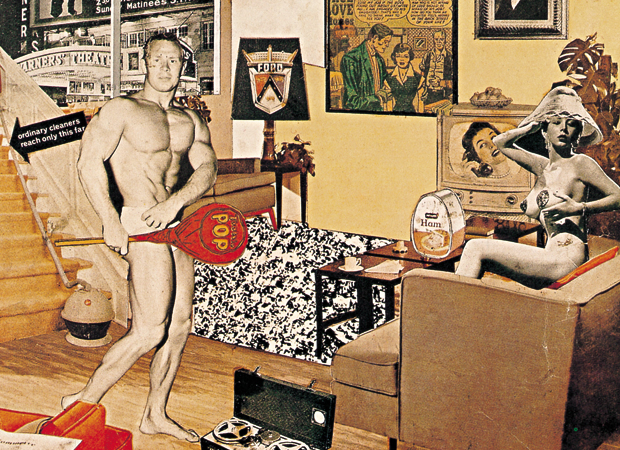What Medium and Subject Did Richard Hamilton Choose for His Pop Art

Richard Hamilton – begetter of Pop Fine art – 1922 - 2011
"People don't seem to sympathize that an creative person is gratuitous to do whatever he wants, and I've ever relished that possibility. I practice any I feel like."
Richard Hamilton, the British Popular Art pioneer has died aged 89. His collage, Only What Is It That Makes Today's Homes So Different, So Appealing? produced for the This Is Tomorrow exhibition of the Independent Grouping in London in 1956, is considered by critics to be one of the earliest Pop Art works. Hamiliton is widely regarded every bit having created some of the most enduring pieces of art by any British painter.
René Magritte and Marcel Duchamp were among his close friends and David Hockney and Peter Blake among those he taught and influenced. The musicians of the Sixties all hung out with him. His silkscreen, Swingeing London, shows Mick Jagger (with Robert Fraser of the Indica gallery) in the back of a police car, shielding his face up against photographers. Paul McCartney asked him to design The Beatles' White Anthology, a laminated white sleeve with the band's proper noun subtly embossed on the cover.
 Richard Hamilton, Swingeing London 67 (1968-1969)
Richard Hamilton, Swingeing London 67 (1968-1969)
He was born in Pimlico, central London, in 1922 and claimed that even every bit a kid he already considered himself a "misfit".
"I decided I was interested in drawing when I was 10. I saw a notice in the library advertizement art classes. The teacher told me that he couldn't have me – these were adult classes, I was also young – only when he saw my drawing he told me that I might as well come up dorsum next calendar week. I used to follow him round like a domestic dog. He was terribly kind to me, and by the time I was xiv I was doing big charcoal drawings of the local downwards and outs."
In the early 1950s Hamilton met Nigel Henderson, afterwards a leading low-cal in the Independent Group of artists to which Hamilton would as well belong. Henderson introduced Hamilton to Duchamp's Green Box, and to D'Arcy Wentworth Thompson'southward 1917 book On Growth and Form which, for Hamilton, was to become a fundamental text. Hamilton is widely credited in bringing Duchamp to a much wider audience.
In 1956 Hamilton created Just What Is Information technology That Makes Today's Homes So Different, And then Appealing? for the catalogue of This Is Tomorrow, the Independent Grouping'south seminal exhibition at the Whitechapel Gallery. The show was a semi-ironic look at the mass-market imagery of the post-state of war age and the slice was made upward of images from magazines including Ladies Dwelling Journal. The bodybuilder featured in the collage is Irwin 'Zabo' Koszewski, winner of Mr LA in 1954.
The success of This Is Tomorrow secured him education assignments notably at the Royal College where Peter Blake and David Hockney were among his students. In the Sixties Bryan Ferry (Roxy Music), John Mark Lancaster (Conservative MP) and Tim Head (creative person) were all taught by him in Newcastle.
Who exactly coined the phrase Pop Art is hotly contested. Hamilton ever claimed he used it in a letter to architects Alison and Peter Smithson with whom he was in talks to stage an exhibition. "Pop Art," he wrote, "is Popular (designed for a mass audition), Transient (brusque-term solution), Expendable (easily forgotten), Depression Cost, Mass Produced, Young (aimed at youth), Wicked, Sexy, Gimmicky, Glamorous, Big Business."
Recently, he told The Observer's Rachel Cooke: "The letter was not intended as a manifesto - I just listed the things I thought were most interesting. I'1000 rather bored with information technology only it'south a overnice fiddling earner!"
In the 1970s he moved with his second Rita to Northward End, an Oxfordshire farm where he based his studio. Here his work became more political. In 1981 he began work on a trilogy of paintings based on the war in Northern Ireland after watching a tv set documentary well-nigh the protest organised by IRA prisoners in Long Kesh Prison house. The Citizen (1981-83) shows IRA prisoner Bobby Sands portrayed as Jesus, with long flowing pilus and a beard.
In 2009 he created a "medal of dishonour" for the British Museum featuring the face of Alastair Campbell, Tony Blair'southward spin-doctor widely accused of 'sexing up' the dossier that took Britain to war in Iraq. Announcing his expiry, Gagosian gallery said he'd been working on a major retrospective that will travel to Los Angeles, Philadelphia, London and Madrid in 2013-14.
Writer and Observer writer Rachel Cooke was one of the last journalists to interview Hamilton at his home. She'south writing a piece for Phaidon.com about her encounter with the begetter of Popular Art. We'll publish it tomorrow morning.
To hear Hamilton in our Speaking of Fine art series from 1983 click here.
Source: https://www.phaidon.com/agenda/art/articles/2011/september/13/richard-hamilton-father-of-pop-art-1922-2011/
0 Response to "What Medium and Subject Did Richard Hamilton Choose for His Pop Art"
Enregistrer un commentaire